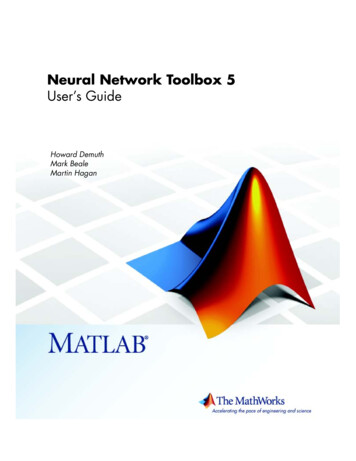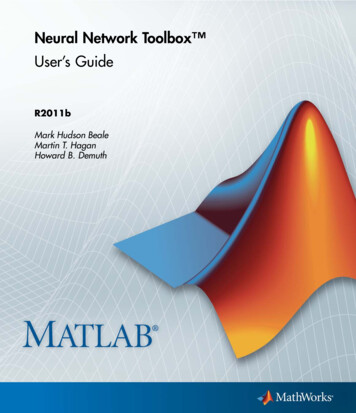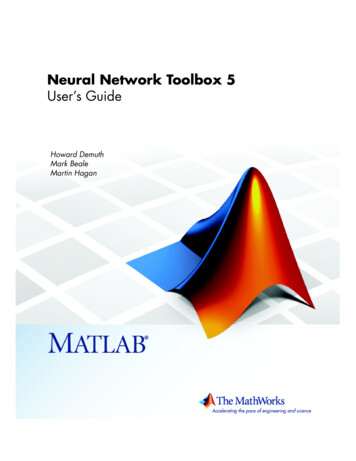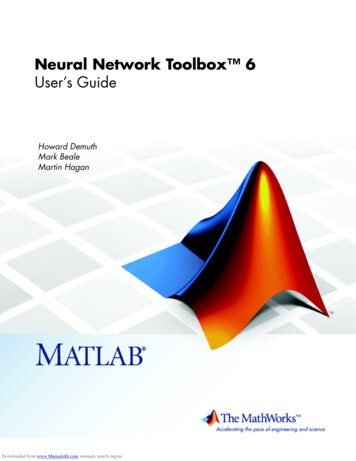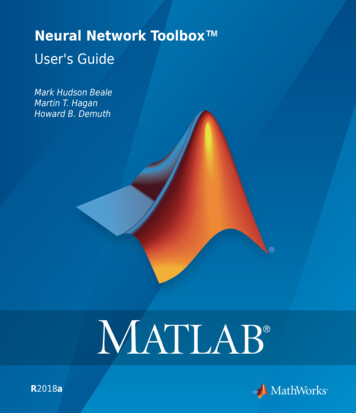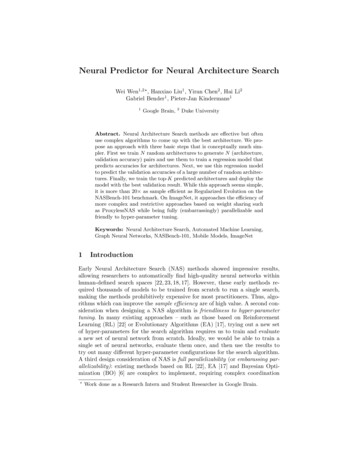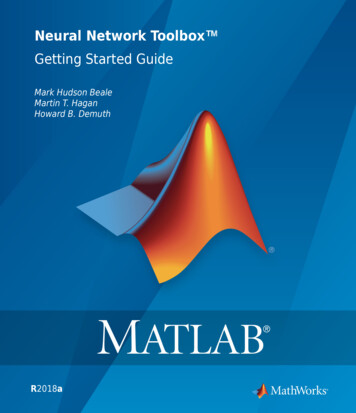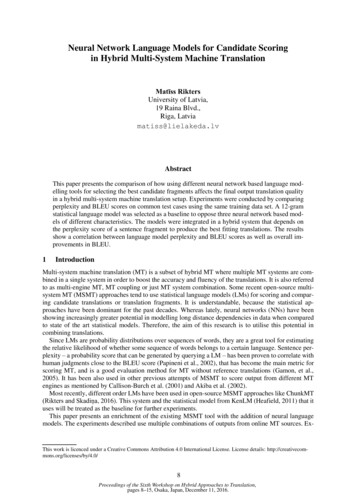
Transcription
Neural Network Language Models for Candidate Scoringin Hybrid Multi-System Machine TranslationMatīss RiktersUniversity of Latvia,19 Raina Blvd.,Riga, Latviamatiss@lielakeda.lvAbstractThis paper presents the comparison of how using different neural network based language modelling tools for selecting the best candidate fragments affects the final output translation qualityin a hybrid multi-system machine translation setup. Experiments were conducted by comparingperplexity and BLEU scores on common test cases using the same training data set. A 12-gramstatistical language model was selected as a baseline to oppose three neural network based models of different characteristics. The models were integrated in a hybrid system that depends onthe perplexity score of a sentence fragment to produce the best fitting translations. The resultsshow a correlation between language model perplexity and BLEU scores as well as overall improvements in BLEU.1IntroductionMulti-system machine translation (MT) is a subset of hybrid MT where multiple MT systems are combined in a single system in order to boost the accuracy and fluency of the translations. It is also referredto as multi-engine MT, MT coupling or just MT system combination. Some recent open-source multisystem MT (MSMT) approaches tend to use statistical language models (LMs) for scoring and comparing candidate translations or translation fragments. It is understandable, because the statistical approaches have been dominant for the past decades. Whereas lately, neural networks (NNs) have beenshowing increasingly greater potential in modelling long distance dependencies in data when comparedto state of the art statistical models. Therefore, the aim of this research is to utilise this potential incombining translations.Since LMs are probability distributions over sequences of words, they are a great tool for estimatingthe relative likelihood of whether some sequence of words belongs to a certain language. Sentence perplexity – a probability score that can be generated by querying a LM – has been proven to correlate withhuman judgments close to the BLEU score (Papineni et al., 2002), that has become the main metric forscoring MT, and is a good evaluation method for MT without reference translations (Gamon, et al.,2005). It has been also used in other previous attempts of MSMT to score output from different MTengines as mentioned by Callison-Burch et al. (2001) and Akiba et al. (2002).Most recently, different order LMs have been used in open-source MSMT approaches like ChunkMT(Rikters and Skadiņa, 2016). This system and the statistical model from KenLM (Heafield, 2011) that ituses will be treated as the baseline for further experiments.This paper presents an enrichment of the existing MSMT tool with the addition of neural languagemodels. The experiments described use multiple combinations of outputs from online MT sources. Ex-This work is licenced under a Creative Commons Attribution 4.0 International License. License details: dings of the Sixth Workshop on Hybrid Approaches to Translation,pages 8–15, Osaka, Japan, December 11, 2016.
periments described in this paper are performed for English-Latvian. Translating from and to other languages is supported, but it has some limitations as described in the original paper. The code of thedeveloped system is freely available at GitHub1.The structure of this paper is as following: Section 2 summarizes related work. Section 3 describesthe architecture of the baseline system. Section 4 outlines the LM toolkits that are used in the experiments and section 5 provides the experiment setup and results. Finally, conclusions and aims for furtherdirections of work are summarized.2Related WorkAhsan and Kolachina (2010) describe a way of combining SMT and RBMT systems in multiple setupswhere each one had input from the SMT system added in a different phase of the RBMT system.Barrault (2010) describes a MT system combination method where he combines multiple confusionnetworks of 1-best hypotheses from MT systems into one lattice and uses a language model for decodingthe lattice to generate the best hypothesis.Mellebeek et al. (2006) introduced a hybrid MT system that utilised online MT engines for MSMT.Their system at first attempts to split sentences into smaller parts for easier translation by the means ofsyntactic analysis, then translate each part with each individual MT system while also providing somecontext, and finally recompose the output from the best scored translations of each part (they use threeheuristics for selecting the best translation).Freitag et al. (2015) use a combination of a confusion network and a neural network model. A feedforward neural network is trained to improve upon the traditional binary voting model of the confusionnetwork. This gives the confusion network the option to prefer other systems at different positions evenin the same sentence.3System ArchitectureThe main workflow consists of three main constituents – 1) pre-processing of the source sentences, 2)the acquisition of translations and 3) post-processing - selection of the best-translated chunks and creation of MT output. A visualisation of the whole workflow is presented in Figure 1. It outlines the mainconstituents and sketches their internals.Going into more detail on the chunking part of the pre-processing step, Figure 2 represents the basicworkflow for that. The syntax tree of a sentence is traversed bottom-up, right to left and combinessmaller subtrees with bigger ones when possible thereby creating chunks that are no longer than a quarterof tokens or words in the sentence. This specific maximum length for chunks was chosen in previousexperiments that showed a general decrease of translation quality or no changes at all for longer maximum chunks. However, if the chunker returns a high amount of chunks for a single sentence, this maximum ratio can be adjusted further. More details on the chunking can be found in the paper of Riktersand Skadiņa (2016) and Rikters (2016).For translation, several online MT systems are used. The paper of the baseline system described usingGoogle Translate2, Bing Translator3, Yandex Translate4 and Hugo5. Source languages require compliance with Berkeley Parser (Petrov et al., 2006) parse grammars. The parser is able to learn new grammars from treebanks. Target languages require a language model that is compliant with either KenLMor one of the NN LM tools. New LMs can also be trained using monolingual plain text files as input.1Machine translation system combination using neural network language models - https://github.com/M4t1ss/BatchChunkCombiner2 Google Translate API - https://cloud.google.com/translate/3 Microsoft Translator Text API - torapi.aspx4 Yandex Translate API - https://tech.yandex.com/translate/5 Latvian public administration machine translation service API - http://hugo.lv/TranslationAPI9
Sentence tokenizationSyntactic parsingSentence chunkingTranslation with different MT systemsGoogleTranslateSelection of the besttranslated TranslateOutputFigure 1. General workflow of the translation process. (Rikters and Skadiņa 2016)Tree datastructurecwc – chunk word countswc – sentence word countSentenceparse treePost-order traversalTraverse tree/subtreecwc swc / 4Addchunkto listcwc 1Chunk of currentnode/subtreecwc 1genitive phraseCombine with thelast chunk in the listList ofchunksNon-alphabeticalTree data structurewith marked chunksFigure 2. Illustration of how chunks are selected44.1Language ModelsBaselineThe baseline language model was trained with the statistical LM toolkit – KenLM. It is an open-sourcetool for fast and scalable estimation, filtering, and querying of language models. It is one of the mostpopular LM tools and is integrated into many phrase-based MT systems like Moses (Koehn et al., 2007),cdec (Dyer et al., 2010), and Joshua (Li et al., 2009). It does the job quite efficiently, thus, it was includedas the only LM option in the baseline system. For training, a large order of 12 was chosen for maximumquality.4.2RWTHLMRWTHLM is a toolkit for training many different types of neural network language models (Sundermeyer et al., 2014). It has support for feed-forward, recurrent and long short-term memory NNs. Whiletraining different NN configurations, the best results were achieved with a model consisting of one feed-10
forward input layer with a 3-word history, followed by one linear layer of 200 neurons with sigmoidactivation function.4.3MemN2NMemN2N trains an end-to-end memory network (Sainbayar et al., 2015) model for language modelling.It is a neural network with a recurrent attention model over a possibly large external memory with architecture of a memory network. Because it is trained end-to-end, the approach requires significantlyless supervision during training.MemN2N requires Torch6 scientific computing framework to be installed for running. Torch is anopen source machine learning library that provides a wide range of algorithms for deep learning. Fortraining, the default configuration was used with an internal state dimension of 150, linear part of thestate 75 and number of hops set to six.4.4Char-RNNChar-RNN7 is a multi-layer recurrent neural network for training character-level language models. Ithas support for recurrent NNs, long short-term memory (LSTM) and rated recurrent units.To run Char-RNN on a CPU, a minimum installation of Torch is also required. Running on a GPUrequires some additional Torch packages. The best scoring model was trained using 2 LSTM layers with1,024 neurons each and the dropout parameter set to 0.5.4.5EnvironmentThe translation experiments were carried out on Ubuntu server with 16GB RAM and 4 cores. This wassufficient because querying the models requires far less computation power than training.Experiments for LM training and perplexity evaluation were done on three desktop workstation machines with different configurations. The KenLM and RWTHLM models were trained on an 8-core CPUwith 16GB of RAM. For training MemN2N a GeForce Titan X (12GB memory, 3,072 CUDA cores)GPU with a 12-core CPU and 64GB RAM. The Char-RNN model was trained on a Radeon HD 7950(3GB memory, 1,792 cores) GPU with an 8-core CPU and 16GB RAM.55.1ExperimentsDataTo train the LMs the Latvian monolingual part of the DGT-TM (Steinberger et al., 2013) was used. Itconsists of 3.1 million legal domain sentences. In the case of training an LM with Char-RNN only thefirst half of this corpus (1.5 million sentences) was used in order to speed up the training process as wellas because the character level model requires much less training data when compared with the others.When training all NN LMs evaluation and validation datasets were automatically derived from the training data with the proportion of 97% for training, 1.5% for validation and 1.5% for testing. The finalevaluation data consisted of 1,134 sentences randomly selected out of a different legal domain corpus –the JRC Acquis corpus version 3.0 (Steinberger et al., 2006).The translation experiments were conducted on the English – Latvian part of the JRC Acquis corpusfrom which both the test data and data for training of the language model were retrieved. The test datacontained 1,581 randomly selected legal domain sentences.For testing on a general domain, the ACCURAT balanced evaluation corpus (Skadiņš et al., 2010)was selected. The general domain test data consists of 512 sentences.A 12-gram language model for the baseline was trained using KenLM.6A scientific computing framework for luajit - http://torch.chMulti-layer Recurrent Neural Networks (LSTM, GRU, RNN) for character-level language models in Torchhttps://github.com/karpathy/char-rnn711
5.2Language Modelling ExperimentsTo justify using different language modelling approaches, different language models were trained withthe same and similar (half of the corpus in one case) training data. Table 1 shows differences in perplexity evaluations that outline the superiority of NN LMs. It also shows that the statistical model is muchfaster to train on a CPU and that NN LMs train more efficiently on 7136.4725.7724.46Trainingcorpus ime1 hour7 days4 days2 daysBLEU19.2318.7818.8119.53Table 1. Results of language model perplexity .470.510.560.600.650.700.740.790.840.88LossSince Char-RNN achieved the best results, several in-depth experiments were conducted using justthis tool with varying training dataset sizes (for faster training) and NN layer combinations. Figure 3shows how the network evolves in a setup with two 512-neuron layers. This experiment was conductedon a smaller dataset – only 1/6th of the corpus – allowing it to run for more epochs without early stopping.The perplexity on test data gradually decreased, reaching a lowest score of 22.18.EpochlossPerplexityFigure 3. Changes of training loss and perplexity when training a two-layer Char-RNN with 512 neurons on 500 000 er variation for training a LM with Char-RNN is shown in Figure 4. Here 1/3rd of the corpuswas used to train a 3-layer RNN with 1,024 neurons per layer. The lowest achieved perplexity was 21.23after training one day on a GPU.15.000.11 0.20 0.32 0.41 0.50 0.61 0.70 0.79 0.88 1.00 1.09 1.20 1.29 1.40 1.47 1.56 1.67 1.74 1.77EpochlossPerplexityFigure 4. Changes of training loss and perplexity when training a three-layer Char-RNN with 1024 neurons on 1 million sentences12
5.3Machine Translation ExperimentsThe last column of Table 1 shows differences in BLEU scores when NN LMs were used. Correlationbetween LM perplexity and the resulting BLEU score is visible as well as a slight improvement in theoverall result. Again, due to the outstanding scores of Char-RNN models, they were inspected closer tosee how BLEU changes along with perplexity.The following charts show how perplexity correlates with BLEU in translation test cases on the general domain and legal domain test datasets. Figure 5 represents results from evaluating a combination ofGoogle and Bing (BG) online MT translations (denoted with darker blue colours) and a combination ofHugo and Yandex (HY) online MT (brighter blue colours) on the general domain test dataset. The trendlines (dotted) indicate that for this dataset the combination of BG stays mostly stable but the combinationof HY gradually improves as the perplexity of the LM gets lower.Whereas Figure 6 shows results of combining the same MT on the legal domain test dataset. In thiscase, while perplexity becomes lower at each time step, the linear trend line for BLEU score of the BGhybrid system does not show a tendency towards climbing higher. As opposed to the BLEU score trendline for HY hybrid system, that showcases improvement along with 0BLEUPerplexity45.0025.0013.0020.0015.0012.000.11 0.20 0.32 0.41 0.50 0.61 0.70 0.79 0.88 1.00 1.09 1.20 1.29 1.40 1.47 1.56 1.67 1.74 1.77EpochPerplexityBLEU-HYBLEU-BGLinear (BLEU-HY)Linear 0.0015.00BLEUFigure 5. Changes of perplexity when training a three-layer Char-RNN with 1,024 neurons on 1 million sentences and its effect on BLEU scorewhen used in MSMT for combining Bing and Google (BG); Hugo and Yandex (HY) on the general domain test dataset.0.11 0.20 0.32 0.41 0.50 0.61 0.70 0.79 0.88 1.00 1.09 1.20 1.29 1.40 1.47 1.56 1.67 1.74 1.77EpochPerplexityBLEU-BGBLEU-HYLinear (BLEU-BG)Linear (BLEU-HY)Figure 6. Changes of perplexity when training a three-layer Char-RNN with 1,024 neurons on 1 million sentences and its effect on BLEUscore when used in MSMT for combining Bing and Google (BG); Hugo and Yandex (HY) on the legal domain test dataset.ConclusionThis paper described ways to improve the baseline MSMT system with neural network language models.The main goals were to provide more options for language modelling in the translation combination tool13
and to improve translation quality over the baseline. Test cases showed an improvement in BLEU score,when used only with Google and Bing, of 0.35 BLEU points.In the detailed translation experiments where a BLEU score was obtained in every stage of the LMtraining there was only a steady correlation of BLEU and perplexity in the case of using Hugo andYandex translations, which were very different (0.52 – 1.10 BLEU difference with each other) to beginwith. In the case of combining Google and Bing translations where the difference was far less significant(0.3 – 0.8 BLEU difference with each other), the BLEU scores of the NN model hybrid were less uniform with perplexity. This indicates that out of very similar options, even the NN model fluctuates withits predictions but it does get more confident in cases where the difference is more obvious.Adding alternative resources to select from in each step of the translation process could benefit themore advanced user base. For instance, the addition of more online translation APIs like Baidu Translate(Zhongjun, 2015) would expand the variety of choices for translations. A configurable usage of differentsyntactic parsers like SyntaxNet - Neural Models of Syntax (Andor et al., 2016) is likely to improve thetranslation process.Another interesting direction to investigate would be how this system performs when given translations of chunks from locally trained (instead of online) MT systems. For instance, a combination a Moses system with Apertium (Forcada et al., 2011) and even a neural MT system like Nematus (Sennrichet al., 2016).ReferenceAhsan, A., Kolachina, P.: Coupling Statistical Machine Translation with Rule-based Transfer and Generation,AMTA-The Ninth Conference of the Association for Machine Translation in the Americas. Denver, Colorado(2010)Akiba, Y., Watanabe, T., Sumita, E.: Using language and translation models to select the best among outputs frommultiple MT systems. Proceedings of the 19th international conference on Computational Linguistics-Volume1. Association for Computational Linguistics. (2002)Andor, D., Alberti, C., Weiss, D., Severyn, A., Presta, A., Ganchev, K., Collins, M.: Globally normalized transition-based neural networks. arXiv preprint arXiv:1603.06042 (2016)Barrault, L.: MANY: Open source machine translation system combination. The Prague Bulletin of MathematicalLinguistics 93: 147-155. (2010)Callison-Burch, C., Flournoy, R. S.: A program for automatically selecting the best output from multiple machinetranslation engines. Proceedings of the Machine Translation Summit VIII. (2001)Dyer, C., Weese, J., Setiawan, H., Lopez, A., Ture, F., Eidelman, V., Ganitkevitch, J., Blunsom, P., Resnik, P.:cdec: A decoder, alignment, and learning framework for finite-state and context-free translation models. Proceedings of the ACL 2010 System Demonstrations. Association for Computational Linguistics, (2010)Forcada, M.L., Ginestí-Rosell, M., Nordfalk, J., O’Regan, J., Ortiz-Rojas, S., Pérez-Ortiz, J.A., Sánchez-Martínez,F., Ramírez-Sánchez, G. and Tyers, F.M., 2011. Apertium: a free/open-source platform for rule-based machinetranslation. Machine translation, 25(2), pp.127-144.Freitag, M., Peter, J., Peitz, S., Feng, M., Ney, H.: Local System Voting Feature for Machine Translation SystemCombination. In EMNLP 2015 Tenth Workshop on Statistical Machine Translation (WMT 2015), pages 467–476, Lisbon, Portugal. (2015)Gamon, M., Aue, A., Smets, M.: Sentence-level MT evaluation without reference translations: Beyond languagemodeling. Proceedings of EAMT. (2005)Heafield, K.: KenLM: Faster and smaller language model queries. Proceedings of the Sixth Workshop on Statistical Machine Translation. Association for Computational Linguistics. (2011)Koehn, P., Hoang, H., Birch, A., Callison-Burch, C., Federico, M., Bertoldi, N., Cowan, B., Shen, W., Moran, C.,Zens, R., Dyer, C.: Moses: Open source toolkit for statistical machine translation. Proceedings of the 45th annual meeting of the ACL on interactive poster and demonstration sessions. Association for Computational Linguistics, (2007)Li, Z., Callison-Burch, C., Dyer, C., Ganitkevitch, J., Khudanpur, S., Schwartz, L., Thornton, W.N., Weese, J.,Zaidan, O.F.: Joshua: An open source toolkit for parsing-based machine translation. Proceedings of the FourthWorkshop on Statistical Machine Translation. Association for Computational Linguistics, (2009)14
Mellebeek, B., Owczarzak, K., Van Genabith, J., Way, A.: Multi-engine machine translation by recursive sentencedecomposition. Proceedings of the 7th Conference of the Association for Machine Translation in the Americas,110-118. (2006)Papineni, K., Roukos, S., Ward, T., Zhu, W. J.: BLEU: a method for automatic evaluation of machine translation.Proceedings of the 40th annual meeting on association for computational linguistics. Association for Computational Linguistics. (2002)Petrov, S., Barrett, L., Thibaux, R., Klein, D.: Learning accurate, compact, and interpretable tree annotation. Proceedings of the 21st International Conference on Computational Linguistics and the 44th annual meeting of theAssociation for Computational Linguistics. Association for Computational Linguistics. (2006)Rikters, M.: K-Translate-Interactive Multi-system Machine Translation. International Baltic Conference on Databases and Information Systems. Springer International Publishing (2016)Rikters, M., Skadiņa, I.: Combining machine translated sentence chunks from multiple MT systems. CICLing2016. (2016)Sainbayar, S., Weston, J., Fergus, R.: End-to-end memory networks. Advances in neural information processingsystems. (2015)Sennrich, R., Haddow, B. and Birch, A., 2016. Edinburgh Neural Machine Translation Systems for WMT 16.arXiv preprint arXiv:1606.02891. (2016)Skadiņš, R., Goba, K., Šics, V.: Improving SMT for Baltic Languages with Factored Models. Proceedings of theFourth International Conference Baltic HLT 2010, Frontiers in Artificial Intelligence and Applications, Vol.2192., 125-132. (2010)Steinberger, R., Eisele, A., Klocek, S., Pilos, S., Schlüter, P.: Dgt-tm: A freely available translation memory in 22languages. arXiv preprint arXiv:1309.5226. (2013)Steinberger, R., Pouliquen, B., Widiger, A., Ignat, C., Erjavec, T., Tufis, D., Varga, D.: The JRC-Acquis: A multilingual aligned parallel corpus with 20 languages. arXiv preprint cs/0609058. (2006)Sundermeyer, M., Schlüter, R., Ney, H.: rwthlm-the RWTH aachen university neural network language modelingtoolkit. INTERSPEECH. (2014)Zhongjun, H. E.: Baidu Translate: Research and Products. ACL-IJCNLP 2015 (2015): 61.15
Google Translate 2, Bing Translator 3, Yandex Translate 4 and Hugo 5. Source languages require compli-ance with Berkeley Parser (Petrov et al., 2006) parse grammars. The parser is able to learn new gram-mars from treebanks. T arget language s require a language model that is compliant with either KenLM or one of the NN LM tools.

